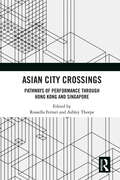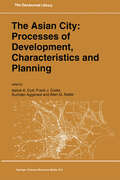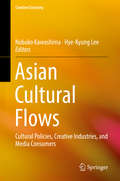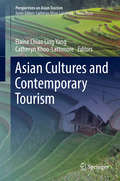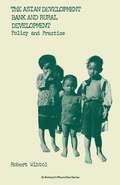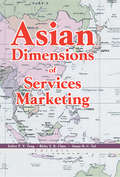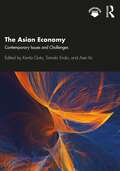- Table View
- List View
Asian Brand Strategy (Revised and Updated): Building and Sustaining Strong Global Brands in Asia
by M. RollThis second edition of the bestselling Asian Brand Strategy takes a look at how Asian brands continue to gain share-of-voice and share-of-market. Featuring a user-friendly strategic model, new research, and case studies, this book provides a framework for understanding Asian branding strategies and Asian brands.
Asian Business and Management: Theory, Practice and Perspectives
by Harukiyo Hasegawa Michael A. WittThe third edition of this core textbook, edited and contributed to by recognised international authorities on the subject, outlines the critical contextual and theoretical issues of business and management in Asia and offers a fresh, topical analysis of management in the major Asian nations. Featuring an accessible two-part structure and updated with the latest research, the book will enable students to assess Asian management systems and the strategies adopted by corporations and governments. The text's thought-provoking teaching and learning tools guide students through a number of the key topics in the field, including globalization, regionalism, corporate social responsibility, ethics, ecological issues, industrial relations and sustainability.This is an ideal textbook for upper-level undergraduates and MBA students studying modules in Asian Business and Management. In addition, it is an essential text for managers and executives seeking a more realistic understanding of business and management in Asia as an evolving adaptive system.
Asian Business and Management: Theory, Practice and Perspectives
by Carlos Noronha Harukiyo HasegawaThe second edition of this core textbook, edited and contributed to by recognised international authorities on the subject, outlines the critical contextual and theoretical issues of business and management in Asia and offers a fresh, topical analysis of management in the major Asian nations. Featuring an accessible two-part structure and updated with the latest research, the book will enable students to assess Asian management systems and the strategies adopted by corporations and governments. The text’s thought-provoking teaching and learning tools guide students through a number of the key issues in the field, including globalization, regionalism, corporate social responsibility, ethics and sustainability.This is an ideal textbook for upper-level undergraduates and MBA/MA students studying modules in Asian Business and Management. In addition, it is an essential text for managers and executives seeking a more realistic understanding of business and management in Asia as an evolving adaptive system.
ASIAN BUSINESS SYSTEMS (Oxford Handbooks Ser.)
by Michael A. Witt Gordon ReddingMuch of the existing literature within the "varieties of capitalism " (VOC) and "comparative business systems " fields of research is heavily focused on Europe, Japan, and the Anglo-Saxon nations. As a result, the field has yet to produce a detailed empirical picture of the institutional structures of most Asian nations and to explore to what extent existing theory applies to the Asian context. The Oxford Handbook of Asian Business Systems aims to address this imbalance by exploring the shape and consequences of institutional variations across the political economies of different societies within Asia. Drawing on the deep knowledge of 32 leading experts, this book presents an empirical, comparative institutional analysis of 13 major Asian business systems between India and Japan. To aid comparison, each country chapter follows the same consistent outline. Complementing the country chapters are eleven contributions examining major themes across the region in comparative perspective and linking the empirical picture to existing theory on these themes. A further three chapters provide perspectives on the influence of history and institutional change. The concluding chapters spell out the implications of all these chapters for scholars in the field and for business practitioners in Asia. The Handbook is a major reference work for scholars researching the causes of success and failure in international business in Asia.
Asian Businesses in a Turbulent Environment: Uncertainty and Coping Strategies (AIB Southeast Asia)
by Geng Cui T. S. ChanAsian Businesses in a Turbulent Environment explores how Asian firms cope with challenges such as globalization, regional conflict, pressure for greater democracy and environmental protection, and the impact that rising above these challenges will have in their growth prospects.
Asian Century… on a Knife-edge: A 360 Degree Analysis Of Asia's Recent Economic Development
by John WestThis book is open access under a CC BY 4.0 license.This book delves into the widely held belief that the 21st century will be the "Asian Century" by examining the Asia's rapid economic development in the post-war era and the challenges it faces in forging ahead of world leaders in the West.The impact of the current turbulent global political climate on Asia is critically analyzed, employing a holistic and multidisciplinary approach, combining economic, social, political and geopolitical perspectives. Written in an accessible style, the book offers students, business, government, and civil society players powerful insights on Asia.
Asian City Crossings: Pathways of Performance through Hong Kong and Singapore
by Rossella Ferrari Ashley ThorpeAsian City Crossings is the first volume to examine the relationship between the city and performance from an Asian perspective. This collection introduces "city as method" as a new conceptual framework for the investigation of practices of city-based performing arts collaboration and city-to-city performance networks across East- and Southeast Asia and beyond. The shared and yet divergent histories of the global cities of Hong Kong and Singapore as postcolonial, multiethnic, multicultural, and multilingual sites, are taken as points of departure to demonstrate how "city as method" facilitates a comparative analytical space that foregrounds in-betweenness and fluid positionalities. It situates inter-Asian relationality and inter-city referencing as centrally significant dynamics in the exploration of the material and ideological conditions of contemporary performance and performance exchange in Asia. This study captures creative dialogue that travels city-based pathways along the Hong Kong-Singapore route, as well as between Hong Kong and Singapore and other cities, through scholarly analyses and practitioner reflections drawn from the fields of theatre, performance, and music. This book combines essays by scholars of Asian studies, theatre studies, ethnomusicology, and human geography with reflective accounts by Hong Kong and Singapore-based performing arts practitioners to highlight the diversity, vibrancy, and complexity of creative projects that destabilise notions of identity, belonging, and nationhood through strategies of collaborative conviviality and transnational mobility across multi-sited networks of cities in Asia. In doing so, this volume fills a considerable gap in global scholarly discourse on performance and the city and on the production and circulation of the performing arts in Asia.
Asian City Crossings: Pathways of Performance through Hong Kong and Singapore
by Rossella Ferrari; Ashley ThorpeAsian City Crossings is the first volume to examine the relationship between the city and performance from an Asian perspective. This collection introduces "city as method" as a new conceptual framework for the investigation of practices of city-based performing arts collaboration and city-to-city performance networks across East- and Southeast Asia and beyond. The shared and yet divergent histories of the global cities of Hong Kong and Singapore as postcolonial, multiethnic, multicultural, and multilingual sites, are taken as points of departure to demonstrate how "city as method" facilitates a comparative analytical space that foregrounds in-betweenness and fluid positionalities. It situates inter-Asian relationality and inter-city referencing as centrally significant dynamics in the exploration of the material and ideological conditions of contemporary performance and performance exchange in Asia. This study captures creative dialogue that travels city-based pathways along the Hong Kong-Singapore route, as well as between Hong Kong and Singapore and other cities, through scholarly analyses and practitioner reflections drawn from the fields of theatre, performance, and music. This book combines essays by scholars of Asian studies, theatre studies, ethnomusicology, and human geography with reflective accounts by Hong Kong and Singapore-based performing arts practitioners to highlight the diversity, vibrancy, and complexity of creative projects that destabilise notions of identity, belonging, and nationhood through strategies of collaborative conviviality and transnational mobility across multi-sited networks of cities in Asia. In doing so, this volume fills a considerable gap in global scholarly discourse on performance and the city and on the production and circulation of the performing arts in Asia.
The Asian City: Processes of Development, Characteristics and Planning (GeoJournal Library #30)
by Ashok K. DuttIn The Asian City the Asian urbanisation processes, nature and characteristics of the 1990s have been analyzed by countries, by comparing different countries and in an international context. The authors are urban specialists from four continents. This volume has been divided into six parts: Part I Urbanisation in an international context; Part II Comparative urban setting; Part III Urbanisation characteristics by country; Part IV Urban planning; Part V The urban poor, and Part VI Perspectives on urbanization. This work allows the reader to understand Asian urban forms, their evolution, the nature of urbanisation, its impact on economic growth in cities, the living and working conditions of the poor, and urban planning and problems.
Asian Civilization and Asian Development
by Linggui Wang Jianglin ZhaoThis book focuses on the dialogues to improve the communication among Asian countries, which is contributed by world-wide experts from think-tanks, academia and governments. In this book, it involves the topics of Connotation and Evolution of Asian Civilization, Exchanges and Mutual Learning of Asian Civilization, Asian Civilization and Asian Development, Opportunities and Challenges Faced with Asian Civilization, etc.
Asian Cultural Flows: Cultural Policies, Creative Industries, and Media Consumers (Creative Economy #0)
by Nobuko Kawashima Hye-Kyung LeeThis book investigates economic, political, and cultural conditions that have led to transnational flows of culture in Asia. Coverage also looks at the consequences of an increasingly interconnected Asian regional culture as well as policy makers and cultural industries' response to it. The book features essays written by researchers from different countries in Asia and beyond with diverse disciplinary backgrounds. The volume also contains engaging examples and cases with comparative perspectives.The contributors provide readers with grounded analysis in the organizational and economic logics of Asian creative industries, national cultural policies that promote or hinder cultural flows, and the media convergence and online consumers' surging demand for Asianized cultural products. Such insights are of crucial importance for a better understanding of the dynamics of transnational cultural flows in contemporary Asia. In addition, the essays aim to “de-westernize” the study of cultural and creative industries, which draws predominantly on cases in the United States and Europe. The contributors focus instead on regional dynamics of the development of these industries.The popularity of J-Pop and K-Pop in East and Southeast Asia (and beyond) is now well known, but less is known about how this happened. This volume offers readers theoretical tools that will help them to make better sense of those exciting phenomena and other rising cultural flows within Asia and their relevance to the global cultural economy.
Asian Cultures and Contemporary Tourism (Perspectives on Asian Tourism)
by Elaine Chiao Yang Catheryn Khoo-LattimoreThis book focuses on cultures that shape contemporary Asian tourist experiences. The book consists of 10 chapters, which are organised into two themes: Collectivist Culture and Wellbeing. The chapters cover emerging forms of tourism (e.g., wedding and bridal photography tourism, roots/affinity tourism and shamanic tourism), investigate a wide range of topics (e.g., tourist motivation, tourist anxiety and decision making) and consider Asian perspectives from diverse backgrounds (e.g., China, Hong Kong, Singapore, Taiwan, South Korea, Japan, Philippines, Malaysia, Indonesia, India, Bangladesh, and Nepal). The book provides tourism researchers, students and practitioners a consolidated, comprehensive and updated reference for the understanding of Asian tourists.
Asian Designs: Governance in the Contemporary World Order (Cornell Studies in Political Economy)
by Saadia M. PekkanenAsian nations are no longer "rising" powers in the world order; they have risen. How will they conduct themselves in world politics? How will they deploy their considerable and growing power individually and collectively? These questions are critical for global governance. Conventional wisdom claims that, lacking in institutions that accumulate and coordinate the massive economic and growing military strength of Asian nations, the Asian region will continue to punch below its weight in world politics; thin and patchy institutionalization results in political weakness. In Asian Designs, Saadia M. Pekkanen and her collaborators question and provide evidence on these core assumptions of Western scholarship. The book advances a new framework for debate and sophisticated examinations of institutional arrangements for several major issue areas in the world order—security, trade, environment, and public health.
Asian Development Bank and Rural Development (St Antony's Series)
by Robert WihtolDespite the policy change the Asian Development Bank's rural sector projects have continued to focus on increasing production, with little impact on unemployment or poverty. This study examines the reasons - both political and organizational - for the gap between policy practice.
The Asian Developmental State: Reexaminations and New Departures
by Yin-Wah ChuThis volume re-examines the concept of the developmental state by providing further theoretical specifications, undertaking critical appraisal and theoretical re-interpretation, assessing its value for the emerging economies of China and India, and considering its applicability to South Korea and Taiwan.
Asian Dimensions of Services Marketing
by Esther Tang Ricky Chan Susan TaiExplore current trends in the Asian service industry!Asian Dimensions of Services Marketing takes you on a journey through the service industries of Asia. Due to the extraordinary amount of growth in Asian service industries over the past few decades, this sector is expanding greatly in many Asian countries. These changes have had many effects on countries such as China, Korea, Singapore, and Thailand, mostly at the expense of agriculture and manufacturing. This book examines these effects, and establishes ways to achieve success in services marketing. This educational book provides an enlightening look at topics such as: the influence of reference groups in the service industry of Singapore the moderating effect of switching costs on the relationship between service performance and customer satisfaction in the Thai cultural and business setting how multinational professional service firms in South Korea have achieved success the emotional impact of store atmosphere on Chinese customers in a leisure service setting the rapid development of services in Asia, and how to effectively market intangibles to various kinds of consumers
Asian Dimensions of Services Marketing
by Esther Tang Ricky Chan Susan TaiExplore current trends in the Asian service industry!Asian Dimensions of Services Marketing takes you on a journey through the service industries of Asia. Due to the extraordinary amount of growth in Asian service industries over the past few decades, this sector is expanding greatly in many Asian countries. These changes have had many effects on countries such as China, Korea, Singapore, and Thailand, mostly at the expense of agriculture and manufacturing. This book examines these effects, and establishes ways to achieve success in services marketing. This educational book provides an enlightening look at topics such as: the influence of reference groups in the service industry of Singapore the moderating effect of switching costs on the relationship between service performance and customer satisfaction in the Thai cultural and business setting how multinational professional service firms in South Korea have achieved success the emotional impact of store atmosphere on Chinese customers in a leisure service setting the rapid development of services in Asia, and how to effectively market intangibles to various kinds of consumers
The Asian Economic Catharsis: How Asian Firms Bounce Back from Crisis
by Frank RichterOne result of the Asian economic crisis has been to shatter the belief that Asian ways of management are superior to Western ways. Now, just to survive, Asian firms have come to rethink their entire way of managing, and in his latest book, Richter, assisted by his contributing authors, gives a sharply focused analysis of how they are doing it. Emerging questions are how do Asian firms adjust to the new economic realities? and How do they develop their management style?There are plenty of new opportunities in Asia to play the new game, but they must be grasped and productively channeled. Richter and his contributors conclude that in the end, the Asian economic crisis, or catharsis, may well be a blessing in disguise. It provides an opportunity to completely review the way things stand in Asia. Like entrepreneurs who built the Asian economies, today's firms have the opportunity to lead a revival if they can redirect their businesses. This is an important resource for professionals in all multinational organizations and for academics and their upper-level students of international business.
Asian Economies: History, Institutions, and Structures
by Jamus Jerome LimAn insightful and thorough exploration of the economies of Asia In Asian Economies: History, Institutions and Structure, seasoned economist and professor Jamus Jerome Lim provides a comprehensive discussion and incisive analysis of the economies of Asia. In addition to discussing the sharp contrasts between the region’s three major economies—China, India, and Japan—Lim also provides an overview of the rise of the Dragon economies of the East, to the resource-rich economies of the West. The book adopts a unique approach to the treatment of these economies, weaving in aspects of these countries’ economic geography and history, their idiosyncratic institutions and structures, along with providing a comparative and international perspective. The book offers: Careful emphasis on the geographic preconditions and enduring legacy of economic history on the contemporary and future prospects of each of the countries and regions discussed within Examinations of the importance of the political and economic institutions, as well as market and industrial structures, in shaping the trajectories of the economies considered in the book Discussions of the dramatic differences and similarities between the Asian economies, as well as how these differences shape these economies’ interactions with the rest of the worldPerfect for undergraduate and graduate students of economics, Asian Economies will also earn a place on the bookshelves of business and finance professionals seeking to understand the economies of the world’s most diverse and dynamic region.
Asian Economies: History, Institutions, and Structures
by Jamus Jerome LimAn insightful and thorough exploration of the economies of Asia In Asian Economies: History, Institutions and Structure, seasoned economist and professor Jamus Jerome Lim provides a comprehensive discussion and incisive analysis of the economies of Asia. In addition to discussing the sharp contrasts between the region’s three major economies—China, India, and Japan—Lim also provides an overview of the rise of the Dragon economies of the East, to the resource-rich economies of the West. The book adopts a unique approach to the treatment of these economies, weaving in aspects of these countries’ economic geography and history, their idiosyncratic institutions and structures, along with providing a comparative and international perspective. The book offers: Careful emphasis on the geographic preconditions and enduring legacy of economic history on the contemporary and future prospects of each of the countries and regions discussed within Examinations of the importance of the political and economic institutions, as well as market and industrial structures, in shaping the trajectories of the economies considered in the book Discussions of the dramatic differences and similarities between the Asian economies, as well as how these differences shape these economies’ interactions with the rest of the worldPerfect for undergraduate and graduate students of economics, Asian Economies will also earn a place on the bookshelves of business and finance professionals seeking to understand the economies of the world’s most diverse and dynamic region.
The Asian Economy: Spearheading the Recovery from the Global Financial Crisis
by Dilip K. DasThe global financial crisis of 2007-09, and the Great Recession that it engendered, were both a challenge and an opportunity for Asia. The region not only remained unharmed by the global financial crisis initially but also recovered the fastest. In addition, it was also the principal driver of the global recovery. This book analyzes the impact of the global financial crisis and the Great Recession on the Asian economy. Chapters look at the most significant issues related to the Asian economy during the crisis, how it coped with them and how it eventually emerged from them. Dilip K. Das discusses how the Asian economy, particularly the emerging-market economies, spearheaded the recovery of the global economy from the global financial crisis and recession, and goes on to look at how this is of historical significance. Written in a clear, comprehensive and critical manner, this book covers the contemporary academic and policy debates on Asia’s role in the world economy. As such, it is an essential read for students, researchers and public policy professionals interested in Asian Economics as well as studies in the International Political Economy.
The Asian Economy: Spearheading the Recovery from the Global Financial Crisis
by Dilip K. DasThe global financial crisis of 2007-09, and the Great Recession that it engendered, were both a challenge and an opportunity for Asia. The region not only remained unharmed by the global financial crisis initially but also recovered the fastest. In addition, it was also the principal driver of the global recovery. This book analyzes the impact of the global financial crisis and the Great Recession on the Asian economy. Chapters look at the most significant issues related to the Asian economy during the crisis, how it coped with them and how it eventually emerged from them. Dilip K. Das discusses how the Asian economy, particularly the emerging-market economies, spearheaded the recovery of the global economy from the global financial crisis and recession, and goes on to look at how this is of historical significance. Written in a clear, comprehensive and critical manner, this book covers the contemporary academic and policy debates on Asia’s role in the world economy. As such, it is an essential read for students, researchers and public policy professionals interested in Asian Economics as well as studies in the International Political Economy.
The Asian Economy: Contemporary Issues and Challenges
by Kenta Goto Tamaki Endo Asei ItoThe book is a key reading which provides a comprehensive and systematic overview of the contemporary Asian economy. The book focuses on the structural changes that are rapidly transforming the regional economic landscape in the 21st century. It highlights the concomitant challenges that have arisen, and further discusses prospects and potentialities of Asian economies given this new economic environment. The book also looks at broader social issues that are both the cause and result of these new and complex economic dynamism in Asia. Understanding the Asian economy cannot be achieved without understanding the new interrelationships and complexities that have evolved from this context, which continue to be driven by drastic changes in technological, demographic, and social structures, among others. Each of the chapters are titled based on "issues" and are framed in present continuous tense, intended to capture and emphasize the progressiveness of this new dynamism that are transforming the region in a fundamental way.
The Asian Economy: Contemporary Issues and Challenges
by Kenta Goto Tamaki Endo Asei ItoThe book is a key reading which provides a comprehensive and systematic overview of the contemporary Asian economy. The book focuses on the structural changes that are rapidly transforming the regional economic landscape in the 21st century. It highlights the concomitant challenges that have arisen, and further discusses prospects and potentialities of Asian economies given this new economic environment. The book also looks at broader social issues that are both the cause and result of these new and complex economic dynamism in Asia. Understanding the Asian economy cannot be achieved without understanding the new interrelationships and complexities that have evolved from this context, which continue to be driven by drastic changes in technological, demographic, and social structures, among others. Each of the chapters are titled based on "issues" and are framed in present continuous tense, intended to capture and emphasize the progressiveness of this new dynamism that are transforming the region in a fundamental way.
The Asian Economy and Asian Money (Contributions to Economic Analysis #287)
by Manoranjan DuttaThis is a new volume in the successful and long-running "CEA Series". The Asian Economy with one common Asian Money is a frontier topic of study in supranational macroeconomics. If the Europeanization of Europe has become a historic reality, the Asianization of Asia cannot be far behind. The paradigm of the European Union (EU) has become a learning model for other continents, especially Asia. In Asia, the process was initiated following the Asian financial crisis of 1997-98, when several newly industrialized Asian economies suffered negative rates of growth of gross domestic product (GDP).The three (Japan, China, and Korea) plus five (Singapore, Malaysia, Thailand, Indonesia, and the Philippines) came together to became the core members of a new regional group. Their annual meetings became an institutional feature of Asian economic cooperation and regional economic integration. In 2003, the group expanded to become the four (Japan, China, Korea, and India) plus 10 model (the original five plus Myanmar, Cambodia, Laos, Brunei Darussalam, and Viet Nam). The book examines the prospects of, the justification for, and the implications of the development of a common Asian currency.






